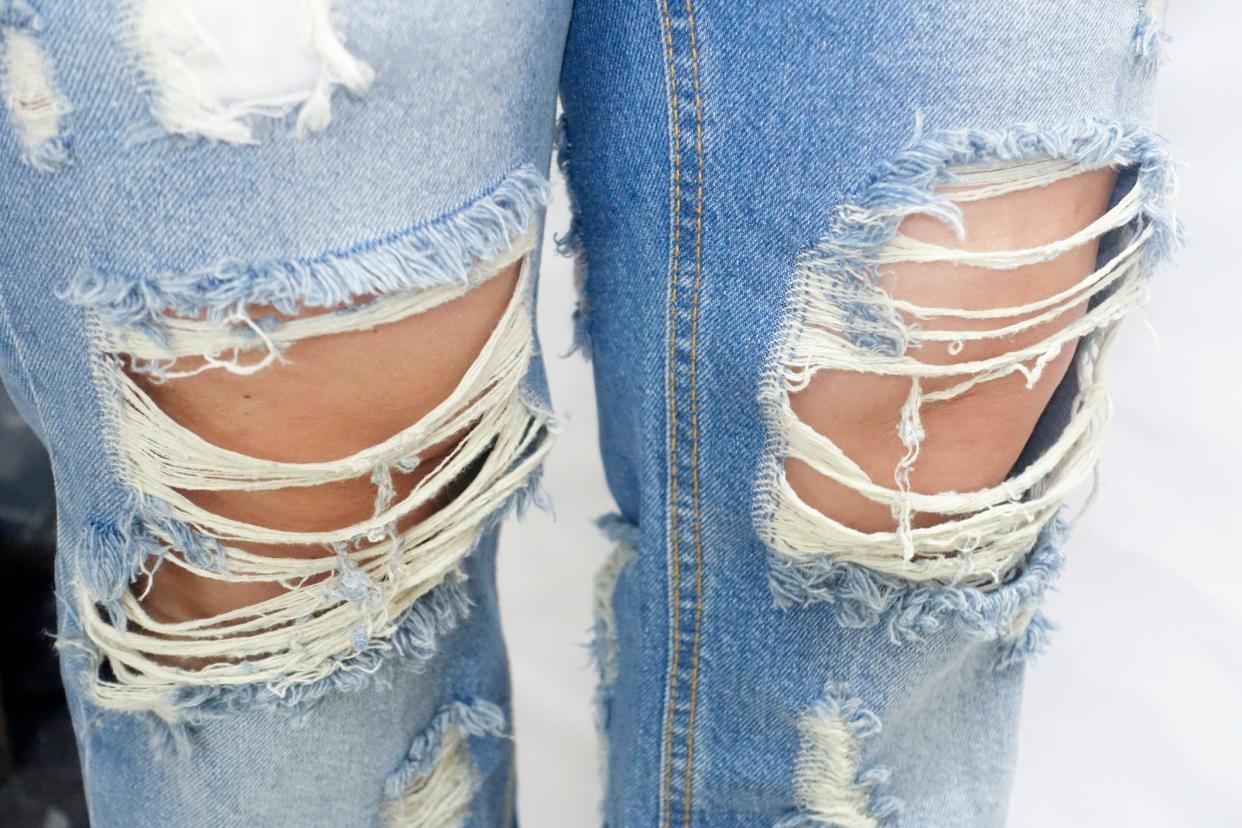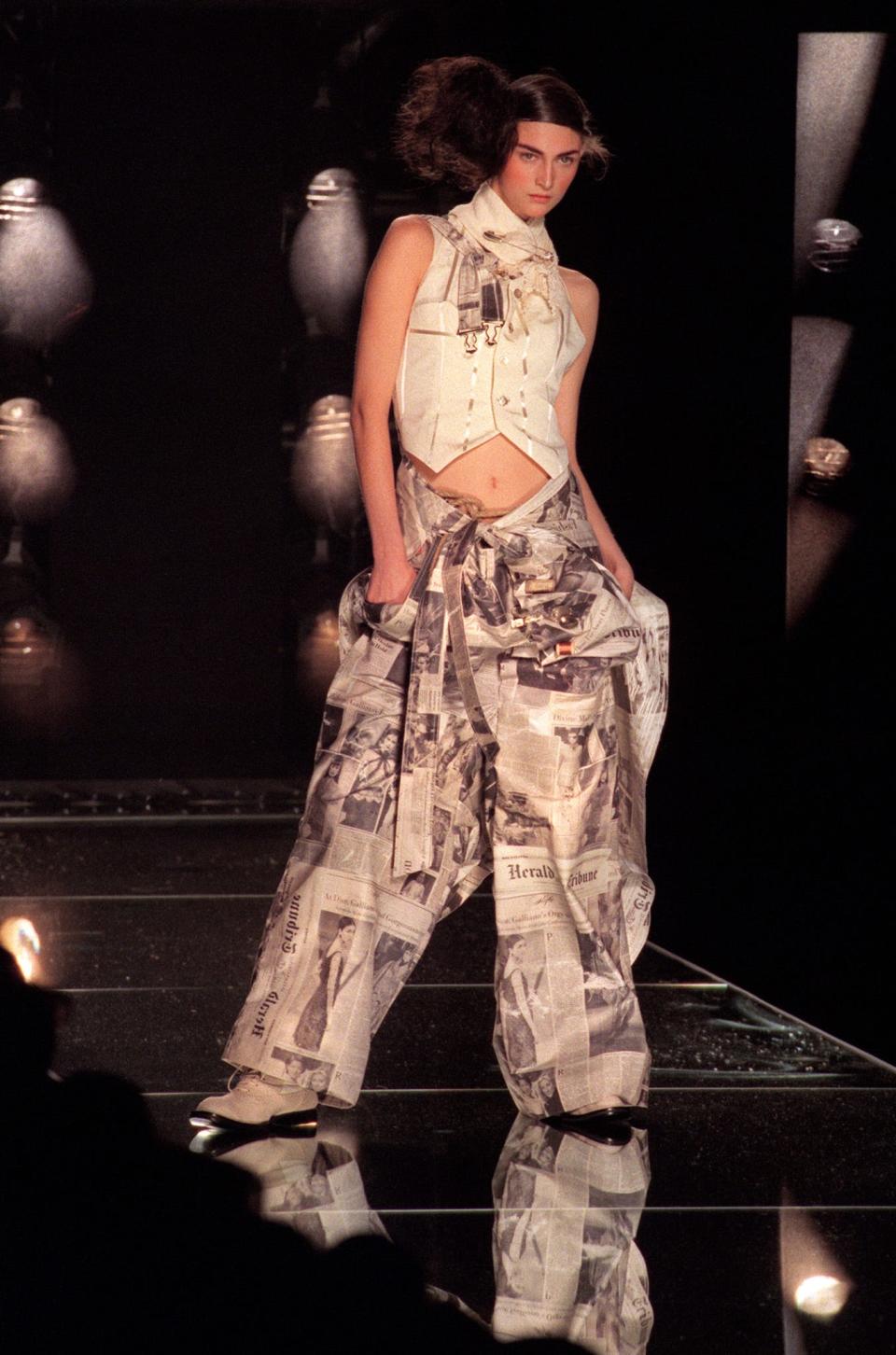Looking poor on purpose is a trend, but why?

When Kim Kardashian took a brief turn from sharing her lavish lifestyle to posting grainy photos posing in a sparsely furnished home in 2017, fans called her out for pretending to look poor. The same year, Balenciaga was mocked for releasing a highly marked up copycat of Ikea's blue shopping bags ($2,145 versus 99 cents).
In 2018, shoppers scratched their heads at the celebrity-loved, faux-distressed Golden Goose sneakers before some shelled out $530 for their own taped-up pair, a version of the shoes that others described as "awful" and "insensitive."
More recently high-end brands have been called out for putting out less-than-luxury-looking products, from Gucci's steep-priced dirty sneakers in 2019 to Balenciaga's sagging sweatpants earlier this month.
This trend has become known as "poverty chic," from celebrities cosplaying poverty to brands glamorizing and romanticizing a homeless aesthetic.
But why do stars and brands engage in a style so divided from their own realities and finances, especially if they risk backlash?
People embrace this aesthetic for a variety of reason, but a big one is relatability, experts say.
"I think the biggest social reason is absolutely wanting to be real, wanting to be authentic, wanting to identify with your fan base and not dress as though you're above," says Susan Scafidi, author of "Who Owns Culture: Appropriation and Authenticity in American Law." "So when we see celebrities embrace poverty chic or even homeless chic, it might be an effort ... to humanize themselves and to make them identifiable to and with their fans or their would-be fan bases. The problem is backlash."
This backlash is partially a result of the celebrity or brand's newfound aesthetic not aligning with their typical image, explains Ali Fazal, vice president of marketing at influencer marketing platform GRIN.
"It obviously speaks to a lack of authenticity," he says. "When that lack of authenticity is perceived on behalf of a consumer, that's where that cognitive dissonance hits. Like, wait a second, this doesn't make sense."
This reach for relatability also comes at a time when class divisions are growing starker in American life, where the rich are getting richer fast, making the faux poverty feel all the more thoughtless.
"We are in a moment where we are, particularly in the past four to five years, engaged in class warfare to an extent," Scafidi says.
Fact check: The super rich did indeed get richer in early weeks of coronavirus pandemic
For some celebrities sporting these looks, it may feel like an authentic part of themselves or their past, says Darnell-Jamal Lisby, fashion historian and assistant curator for the Cleveland Museum of Art.
"Authentically, depending on the celebrity, they're just going to be themselves," he says. "Yes, they have access to money, but their value may not be in fashion."
But he agrees the flip side is also true. Some celebrities "try very hard to look a certain way to feel relatable because it's their PR stunt."
"They take on identities that don't belong to them ... when in reality, that's not even the world that they even grew up with it. They grew up from a place of privilege, and they went into more privilege, and then they're trying to look like they've never had privilege to kind of create that relatability with their millions of fans in a very direct way."
Other times it can be purely aesthetic.
Lisby says style connoisseurs may hop on a trend without meaning to offend.
"It's just them enjoying a trend that the larger fashion hegemony is promoting at a given time," he says.
Scafidi agrees that you can see beauty in things that are torn, ripped or dirty and "look at it merely from a surface, aesthetic perspective."
"(But) that, too, is a little bit misguided," she says. "Because it erases the reality of why someone might be wearing clothes that are dirty or ripped or ill-fitting."
'Homeless chic' to ripped jeans
This trend is not a new one, either. At least not in the last 20 years, Scafidi says. Instead, she argues it's part of the fashion vocabulary of the 21st century.
"A lot of people peg this back to John Galliano for Dior doing the 'homeless chic' collection," she says, which was inspired by his walks along the Seine in Paris. "He would ... see homeless people covered newspapers and he took that aesthetic and turned it into high fashion. Ever since then, we've seen similar collections or similar pieces."

The normalized, everyday version of this is ripped jeans. From the slightly-distressed and hole-y versions found throughout shopping malls adored by teens to the over-the-top torn apart "invisible jeans" made popular by Kendall Jenner a few years ago, this style is everywhere and has been for years.
"If you think of someone who is working class or working poor, and literally works their jeans into rags, that's very different than buying them already torn so you can show a little extra skin," she explains.
Lisby says the phenomenon can be seen even further back in the 18th and 19th century.
"You had aristocrats feeling like, 'Oh I want to live like the the peasants do,' so they wore more stripped down versions of their costume, their fashions. ... They appropriated what their servants wore so that they could feel normal in those kind of private settings," he says.
More: Jill Biden’s tights and why society is obsessed with what older women wear
The risk of 'erasing the community' the trend is based on
Despite the long history of the trend, the continuation of it has potential to harm the same communities it takes inspiration from.
"When it appears that celebrities are trying too hard to look poor, then ...it almost insults people who really have no choice but to wear clothes that are associated with poverty, are less expensive or are perhaps a bit destroyed," Scafidi says.
Not only can it be insulting, but there is concern that these styles can erase the actual communities that struggle with poverty and homelessness.
There were 37.2 million people in poverty last year in the United States, 3.3 million more than in 2019. And according to the National Alliance to End Homelessness, there were 580,466 people experiencing homelessness in America in January 2020.
"If designers and celebrities are emulating a look without conveying any message about the reason for the look, then it does run the risk of erasing the community or diluting our ability to see the community," Scafidi says. "We just have to be careful that we don't, in the process of seeing seeing beauty in destruction, also erase people who are struggling. I think that's the core of why this gets criticized. ... It's insensitive at best, derisive and mocking at worst."
While some make the argument that these styles celebrate the community, Lisby explains there is a disconnect when brands cherry-pick from communities that have been historically neglected.
"On top of that, they're not actually using these collections as teaching moments, educational moments for people to really understand the history of our world, the history of all these other communities that they're taking inspiration from," he says.
And then, to make matters worse, the brands profit off it. Take Balenciaga's latest headline-making item, a pair of sweatpants with boxers poking out the top to imitate sagging pants.
@mr200m__ You know when something feels racist 🥲😂 @sxbwxyy I have questions #fypシ
♬ original sound - Mr200m
The exact origins of the sagging pants style are unclear. However, an intersection of race and socio-economic level is involved.
"There's a history of Black and brown men who have been demonized for wearing that style. That kind of collection would have been a great opportunity to support, let's just say, Black Lives Matter," Lisby says. "To kind of minimize it in that way and translated it into a collection that you're selling closer to thousands of dollars really shows the tone deafness of it all."
He adds, "It's one thing to educate people, but it is another thing to kind of sell and monetize off of other people's experiences and other communities experiences that at one point in time Balenciaga wanted nothing to do with."
How do we stop the cycle?
Scafidi says consumers and celebrities can help stop the collateral damage that may come from embracing the trend.
"Let's be realistic: We're not all going to run straight into our closets and throw out our ripped jeans and distressed sneakers," she says. "However, what we should do is remind ourselves to not let fashion choices obscure our ability to see the people around us, especially the less fortunate."
Lisby believes much of the responsibility falls on design houses.
"They know exactly what they're doing," he says. "They have creative teams, they have people that are stakeholders that green-light these collections. ... This goes through lots of conversation before we actually get to see it. They have the resources to do the research. ... What they don't admit to is that sometimes they're not culturally sensitive."
Fazal says this highlights the additional need for diversity in creative teams, including socio-economic diversity, which is a segment of diversity that is often ignored.
"If everybody in the room and everybody on the creative team comes from a similar type of background, they may not notice how tone deaf it is to emulate someone who's working class or someone who's of a lower socioeconomic status, they may find it more like a novelty than really acknowledging and respecting the true lifestyle that exists," he explains.
While the fashion industry has a certain power, Lisby hopes consumers will become more aware and mindful of where they shop.
"Consumers are going to have to try and be motivated to do more research on their own to be more conscious in who they buy from," he says.
More: Wait, when did Crocs become cool again?
More: Fashion editor Richard Buckley, husband to designer Tom Ford, dies at 72
This article originally appeared on USA TODAY: Poverty chic is trendy with celebrities and brands, but it's harmful

